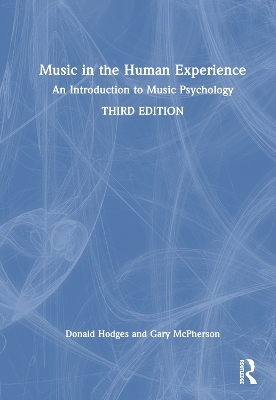
Music in the Human Experience
Routledge (Verlag)
9781032606958 (ISBN)
New to the Third Edition:
New co-author, Gary E. McPherson
Fresh discussions on in-demand topics: social justice in music, fitness for musicians, constructivism, and more
Increased recognition of non-Western music and musical experiences
A digital overhaul of the accompanying multimedia tutorials, now available via www.musicinthehumanexperience.com
Refined and updated content throughout
Donald A. Hodges, formerly the Covington Distinguished Professor of Music Education, is now Professor Emeritus at the University of North Carolina, Greensboro (USA). Gary E. McPherson is the Ormond Chair of Music at the Melbourne Conservatorium of Music, University of Melbourne (Australia).
Part I: Introducing Music Psychology
Chapter 1. What is Music Psychology?
The Purview of Music Psychology
A Model of Music Psychology
Contributions from Biology
Contributions from Anthropology
Contributions from Philosophy
Contributions from Education
Contributions from Psychology
Contributions from Sociology
Contributions from Physics
Contributions from Music
A Brief History of Music Psychology
An Overview of the Literature in Music Psychology
Conclusion
Discussion Questions
Chapter 2. Philosophical Issues in Music Psychology
Human and Musical Nature
Biological Differences
Adaptability
Cultural Development
Symbolic Behaviors
Love
Play
Religion
Technology
Aesthetic Sensitivity
Knowledge
The Interface of Music Philosophy and Music Psychology
General Philosophical Approaches
The Science of Beauty
Experimental Aesthetics
The Golden Mean and Mathematical Influences
A Philosophical Paradigm Shift in Music Psychology
Music as a Way of Knowing
Is Music Psychology Encroaching on Music Philosophy’s Territory?
Seashore’s Involvement with Eugenics
Conclusion
Discussion Questions
Chapter 3. How We Came to be Musical
Rhythm, a Fundamental Life Process
Natural Soundscapes
Parent-Infant Bonding
The Acquisition of Language
Music as a Way of Knowing
Social Organization
Conclusion
Discussion Questions
Chapter 4. Music Around the World and Across Time
Time-Line of Early Artistic Behaviors
Prehistoric Cave and Rock Art
Art and Technology
Invariants
Religion
Celebrations
Altered States of Consciousness
Music: A Human Invariant
Emotional expression (Merriam), Regulation of an individual's emotional, cognitive, or physiological state (Clayton)
Aesthetic enjoyment (Merriam)
Entertainment (Merriam), Personal enjoyment, Games (Gregory)
Communication (Merriam, Gregory)
Symbolic representation (Merriam, Clayton), Personal symbol (Gregory)
Physical response (Merriam), Dancing (Clayton)
Enforcing conformity to social norms (Merriam), Mediation between self and other (Clayton)
Validation of social institutions and religious rituals (Merriam), Ceremonies and festivals; Religious music (Gregory)
Contribution to the continuity and stability of culture (Merriam), Ethnic or group identity (Gregory)
Contribution to the integration of society (Merriam)
Lullabies (Gregory)
Work music (Gregory), Coordination of action (Clayton)
Storytelling (Gregory)
Battle (Gregory)
Salesmanship (Gregory)
Healing, trance (Gregory)
Court (Gregory)
Conclusion
Discussion Questions
Part II: Perceiving, Understanding and Responding to Music
Chapter 5. Acoustical Foundations of Music
What is Sound?
Important Parameters of Sound
Measuring and Describing Sound and Vibration
Frequency
Amplitude
Waveform (Signal Shape)
Time
How Environment Affects Sound
Transmission and Absorption
Reflection
Diffraction
Refraction
Interference
Tuning Systems
Tuning in Western Music
Non-Western Tuning Systems
Acoustics of the Voice and Musical Instruments
The Voice
Aerophones
Chordophones
Idiophones, Membranophones, and Corpophones
Electrophones
Room Acoustics
Conclusion
Discussion Questions
Chapter 6. Musical Hearing
The Hearing Mechanism
Outer Ear
Middle Ear
Inner Ear
From Ear to Brain
The Auditory Cortex
Conclusion
Discussion Questions
Chapter 7. Psychoacoustics and the Perception of Music
The Critical Band
The Perception of Pitch
Pitch Discrimination
Pitch Matching
Pitch Height and Pitch Chroma
Absolute Pitch
Synesthesia
The Perception of Loudness
The Perception of Timbre
The Perception of Duration
Secondary Relationships
Pitch
Loudness
Timbre
Duration
Volume and Density
Conclusion
Discussion Questions
Chapter 8. Music Cognition
Gestalt Laws of Cognitive Organization
Auditory Scene Analysis
Schemata
The Spotlight of Attention
The Cocktail Party Phenomenon and Auditory Stream Segregation
Musical Memory
Statistical Learning in Music
Expectancy Theory
Tonality
Cognition of Musical Elements
Melody and Harmony
Tonality in Melody Cognition
Melodic Contour
Consonance - Dissonance
Rhythm
Timbre
Cognition of Larger Musical Forms
Cross-Cultural Comparative Research in Music
Music and Language
Conclusion
Discussion Questions
Chapter 9. Music and the Brain
Brief Introduction to the Brain
Neural Plasticity
Pruning
Critical and Sensitive Periods
Neural Networks
Multisensory Integration
Music in the Brain
Support from Ancillary Disciplines
Support from Indirect Approaches
Special Musicians
Imaging Techniques for Studying Music
Electroencephalography
Electrocorticography
Event-related Potentials
Magnetoencephalography
Positron-Emission Tomography
Magnetic Resonance Imaging
Functional Magnetic Resonance Imaging
Transcranial Magnetic Stimulation
Diffusion Tensor Imaging
fNIRS: Functional Near-Infared Spectroscopy
Hyperscanning
Imaging Music Perception and Cognition
Imaging Affective Responses to Music
Imaging Musical Performance
Imaging Music Learning
Predictive Coding of Music (PCM) Model
Conclusion
Discussion Questions
Chapter 10. Bodily Responses to Music
Physiological Responses to Music
Heart Rate and Pulse Rate
Blood Pressure
Respiration
Skin Conductance Responses
Neurochemical Responses
Skin, Finger, or Body Temperature
Miscellaneous Responses
Physical Responses to Music
Muscular and Motor Responses
Chills and Tears
Facial Gestures
Body Movements
Discussion of Psychophysiological Variables
Conclusion
Discussion Questions
Chapter 11. Musical Emotions
Introduction to the Study of Emotions
The Role of Expectations in Musical Emotions
Measuring Musical Emotions
Perceived Emotions: The Cognitivist Position
Induced Musical Emotions: The Emotivist Position
A Third Viewpoint: Aesthetic Trinity Theory
Musical Emotions in Everyday Experiences
Conclusion
Discussion Questions
Part III: Being Musical
Chapter 12. The Musical Person
Is Musicality Inherited or Acquired?
Genetic Factors in Musicality
The Acquisition of Musical Attributes
Summary of the Inheritance/Acquisition of Musical Attributes
The Relationship of Musical Attributes to Other Human Attributes
The Musical Personality
Religious and Spiritual Aspects
Musical Identity
Musical Preferences
Preferences for Instruments
Preferences for Musical Genres
The Listener
The Music
Situations and Contexts
Conclusion
Discussion Questions
Chapter 13. Music Performance
Motor Skills
Neuromotor Aspects of Music Making
Motor Aspects of Music Making
Music Performance
The Acquisition of Motor Skills
Audio-Motor and Mirror Neuron Systems
Quantity of Practice
Cognitive Skills
Quality of Practice
Mental Rehearsal
Music Reading
Expressive Skills
Body Movement
Musical Cues for Expressiveness
Musical Creativity
Memory and Creativity
Divergent and Convergent Thinking
Flow
Improvisation
Conclusion
Discussion Questions
Chapter 14. The Psychology of Music Learning
Psychoanalysis
Behavioral Psychology
Cognitive Approaches
Humanistic Psychology
Gestalt Psychology
Developmental Psychology
Social Psychology
Cognitive Psychology
Taxonomies
Music Intelligence
Music Cognition, Music Learning, and Reflective Thinking
Cognitive Neuroscience
Cognitive Load Theory
Explicit Instruction
Worked Examples
Connectivism
Learning Styles
Music Teaching and Learning
Conclusion
Discussion Questions
Chapter 15. Music and Health
Music Therapy
Alzheimer's Disease
Autism
Cerebral Palsy
Dyslexia
Parkinson's Disease and Stroke
Premature and Newborn Infants
Psychiatric Disorders
Music Medicine
Aphasia
Stress, Pain, Anxiety, and the Immune System
Performing Arts Medicine
Hearing HealthMM6.4
Vocal Health
Bodily Health
Psychosocial Health
Performance Anxiety
Other Mental Health Issues
Music and Wellbeing
Conclusion
Discussion Questions
Chapter 16. Music in Social Contexts
Music in Society
From Birth to Death
From Lowest to Highest Cognitive Functioning
From One Person to Thousands
Reflections of Society in Music
Social Behaviors among Performing Musicians
Social Behaviors among Music Listeners
The Influence of Music on Social Behaviors
Music as a Socializing Agent
The Influence of Music in the Workplace
The Influence of Music on Thought, Attitude, and Social Behavior
Conclusion
Discussion Questions
Epilogue: Ruminations on Music Psychology Research
R1. What is music psychology, and who conducts music psychology research?
R2. Interactions between philosophy and music psychology
R3. The triumvirate of theory, research and practice
R4. Basic and applied research
R5. Quantitative and qualitative research
R6. Formal and informal music experiences
R7. Global perspectives
R8. Toward a cultural music psychology
R9. Replications
R10. A music psychology research collaboratory
| Erscheinungsdatum | 01.05.2025 |
|---|---|
| Zusatzinfo | 20 Tables, black and white; 54 Line drawings, black and white; 175 Halftones, black and white; 229 Illustrations, black and white |
| Verlagsort | London |
| Sprache | englisch |
| Maße | 178 x 254 mm |
| Gewicht | 1160 g |
| Themenwelt | Kunst / Musik / Theater ► Musik ► Musiktheorie / Musiklehre |
| Geisteswissenschaften ► Psychologie ► Allgemeine Psychologie | |
| Geisteswissenschaften ► Psychologie ► Verhaltenstherapie | |
| Medizin / Pharmazie ► Medizinische Fachgebiete ► Psychiatrie / Psychotherapie | |
| ISBN-13 | 9781032606958 / 9781032606958 |
| Zustand | Neuware |
| Informationen gemäß Produktsicherheitsverordnung (GPSR) | |
| Haben Sie eine Frage zum Produkt? |
aus dem Bereich


